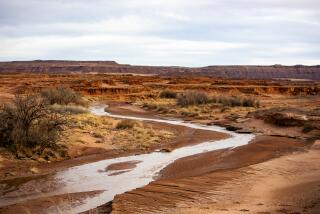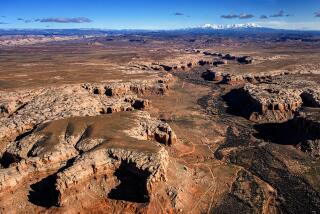Boundary Disputes With Indians Could Block Accord on New Eskimo Territory : Canada: The two groups have hunted across overlapping regions for millennia. A plebiscite scheduled for March is expected to be close.
- Share via
TORONTO — The likely creation of a huge new Arctic territory for Eskimos marks a watershed in Canada’s efforts to address the many longstanding grievances of its native peoples. But the prospect of the new realm has pitted Canada’s various aboriginal peoples one against the other, as they argue over how best to achieve their ultimate goal: self-government.
Stephen Hazell, executive director of the Canadian Arctic Resources Committee, called the agreement a “shining star” and said Tuesday that it is “one of the better achievements of the federal government.”
But A. J. Felix, head of the Prince Albert Tribal Council, an Indian group, called it “a very black day,” and he worried that “the government of Canada can unilaterally deny the rights of one group of people by claiming to recognize the rights of another group of people.”
He said the Tribal Council plans to go to court before Christmas to block the deal with the Eskimos.
The prospect of new lands for the Inuit--as Canadian Eskimos prefer to be called--loomed large this week, when the Canadian government and an Inuit negotiating team announced Monday that they had reached a huge land-claims settlement after 16 years of talks.
If all goes as planned, Canada will split its existing Northwest Territories in two and create an Inuit territory called Nunavut, which means “Our Land” in Inuktitut, the language of the eastern Arctic.
Nunavut would be enormous--772,000 square miles--bigger than California and Alaska combined, covering a fifth of Canada’s total landmass. The 17,000 Inuit who live in its frozen, barren wastes would eventually govern themselves.
The settlement calls for the Inuit to own 136,000 square miles of Nunavut outright, and to extinguish their claims to the rest of the land, while retaining fishing and hunting rights throughout the territory. They would also receive nearly $1 billion over 14 years, including more than $10 million in training funds, so they will be able to administer their own territorial government.
At the moment, illiteracy is a serious problem in the Canadian Arctic, and if Nunavut became a going concern tomorrow, it would have to be run by transplanted whites from the south.
But Nunavut is not a done deal. “There’s still quite a lot of uncertainty” surrounding the accord, said Jim Bell, a writer with the Nunatsiaq News, the newspaper in Iqaluit, a town of 3,200 at the southern end of Baffin Island that would probably become the territorial capital, if Nunavut becomes a reality.
A major sticking point is the objection of Indians in the western Arctic to Nunavut’s proposed boundaries. The Indians and Inuit have hunted and trapped across overlapping regions of northern Canada for millennia; Indians say some lands designated for Nunavut are theirs.
The Inuit and the Indians will be able to vote on the boundaries in a Northwest Territories plebiscite scheduled for March 16. Observers say the vote could be close.
“I think it will be a rough ride, because the Dene and the Metis don’t agree with the boundaries that are being imposed,” said Jack Anawak, Canada’s only Eskimo member of Parliament. (The Dene nation is made up of half a dozen Indian tribes in the western Arctic and sub-Arctic; Metis are peoples of mixed Indian and white lineage.)
Bell observed: “If the plebiscite on the boundary fails, then the whole thing could fall apart.”
It isn’t just boundaries that are in contention. The Indians and Inuit also hold widely divergent views on strategies for negotiating land disputes with the Canadian government.
The Inuit, seeking the right to govern themselves, have expressed a willingness to trade away their aboriginal claims to ancestral lands. Eskimos in the western Arctic signed such a settlement in 1984 and have expressed few regrets. Indians, meanwhile, want self-government just as much as the Inuit, but they have tended to reject deals in which they have to give up their sweeping claims to ancestral lands in exchange.
The Dene, for example, have turned away from a comprehensive agreement in principle that would have required them to give up aboriginal title to vast tracts of the sub-Arctic. And in northern Quebec, members of the Cree nation who gave up their aboriginal claims to lands now being flooded by a massive hydroelectric development now complain that they were cheated and that Ottawa reneged on some of its promises.
Arguments of the Indians aside, there are misgivings even among the Inuit themselves about the tradeoffs involved in the Nunavut accord.
“I’m looking at this agreement in principle with some grave concerns,” said Anawak. “I’m in full support of having a land-claims deal, and I’m in full support of having Nunavut. But what’s happening now is, we are getting (simple) title to 136,000 square miles of land, and giving up (aboriginal) title to the other 600,000 and some-odd square miles. To me, that is unacceptable.”
For all the uncertainty, the agreement marks a breakthrough for the Inuit, who have been trying since 1975 to get the federal government to create a territory for them. Observers in Canada say the government finally moved on the issue because native rights has suddenly become a pressing topic.
Canadian Indians went from impoverished obscurity to center stage in the summer of 1990, when a lone Cree in Manitoba, Elijah Harper, managed to block a key set of amendments that the federal government had been trying to make to the constitution. The amendments were highly unpopular with white Canadians, and when Harper fought them, he--and by extension, all Indians--suddenly became the darlings of the silent majority.
Not long afterward, armed Mohawks engaged in a weeks-long standoff with Quebec police and the Canadian army in a dispute over whether a golf course could be built on traditional Mohawk lands. The idea that Indians might be pushed around so that a few white men could play golf incensed ordinary Canadians, and again, many rallied around the Indians.
Besides seeking to reach a settlement with the Inuit, the government recently said that it may amend the constitution so as to recognize native peoples’ right to self-government.
More to Read
Sign up for Essential California
The most important California stories and recommendations in your inbox every morning.
You may occasionally receive promotional content from the Los Angeles Times.










